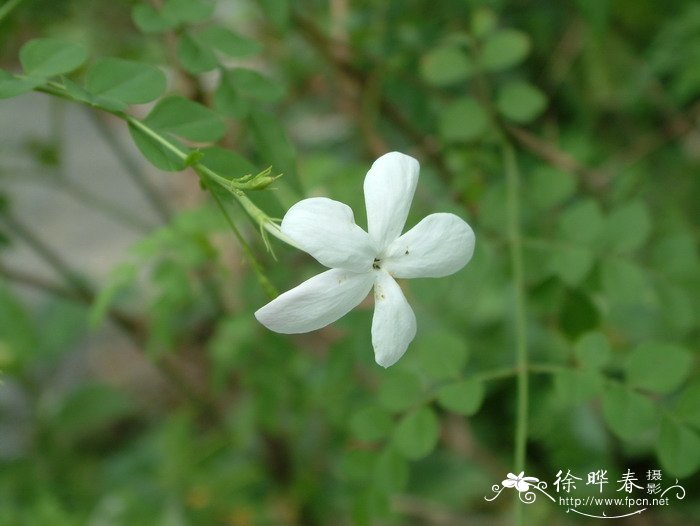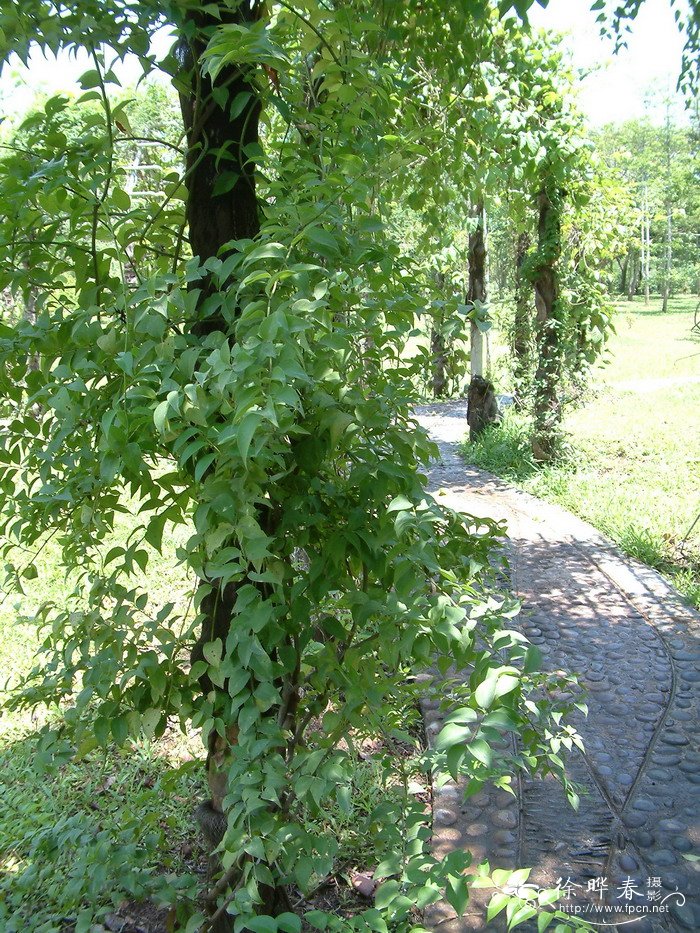素馨 Jasminum officinale
中文名(Chinese Name):素馨
学名(Scientific Name):Jasminum officinale L.
英文名(English Common Name):poet's jasmine
别名(Chinese Common Name):
异名(Synonym):Jasminum officinale f. grandiflorum (L.) Kobuski Jasminum officinale var. grandiflorum (L.) Stokes Jasminum officinale subsp. grandiflorum (L.) E.Laguna
科属(Family & Genus):木犀科(Oleaceae)素馨属
形态特征(Description):攀援灌木,高1-4米。小枝圆柱形,具棱或沟。叶对生,羽状深裂或具5-9小叶,叶长3-8厘米,宽3-6厘米;叶轴常具窄翼,叶柄长0.5-4厘米;小叶片卵形或长卵形,顶生小叶片常为窄菱形,长0.7-3.8厘米,宽0.5-1.5厘米,先端急尖、渐尖、钝或圆,有时具短尖头、基部楔形、钝或圆。聚伞花序顶生或腋生,有花2-9朵;花序梗长0-3厘米;苞片线形,长2-3毫米;花梗长0.5-2.5厘米,花序中间之花的梗明显短于周围之花的梗;花芳香;花萼无毛,裂片锥状线形,长(3-)5-10毫米;花冠白色,高脚碟状,花冠管长1.3-2.5厘米,裂片多为5枚,长圆形,长1.3-2.2厘米,宽0.8-1.4厘米。果未见。花期8-10月。
分布(Distribution):产云南、四川、西藏及喜马拉雅地区。生海拔约1800米石灰岩山地。
用途(Use):本种花芳香而美丽,常栽培供观赏。
引自中国植物志英文版:FOC Vol. 15 Page 313
Jasminum grandiflorum Linnaeus, Sp. Pl., ed. 2. 1: 9. 1762.
素馨花 su xin hua | Oleaceae | Jasminum
Jasminum officinale Linnaeus var. grandiflorum (Linnaeus) Stokes; J. officinale f. grandiflorum (Linnaeus) Kobuski.
Shrubs scandent, 2-4 m. Branchlets terete, angular or grooved. Leaves opposite, pinnatipartite or compound with 5-9 leaflets; petiole 0.5-4 cm; leaflet blade ovate or narrowly so (terminal one usually narrowly rhomboid), 0.7-3.8 × 0.5-1.5 cm, base cuneate or blunt, apex acute, acuminate, or blunt, sometimes mucronate. Cymes terminal or axillary, 2-9-flowered; bracts linear, 2-3 mm. Pedicel 0.5-2.5 cm, middle pedicel of cymes conspicuously shorter. Calyx glabrous; lobes subulate-linear, (3-)5-10 mm. Corolla white, salverform; tube 1.3-2.5 cm; lobes often 5, oblong, 1.3-2.2 cm. Fruit not seen. Fl. Aug-Oct. 2n = 26*.
Widely grown in Sichuan, Yunnan [native of Arabia]
Cultivated in warm and tropical countries for its fragrant flowers.

 (责任编辑:徐晔春)
(责任编辑:徐晔春)
学名(Scientific Name):Jasminum officinale L.
英文名(English Common Name):poet's jasmine
别名(Chinese Common Name):
异名(Synonym):Jasminum officinale f. grandiflorum (L.) Kobuski Jasminum officinale var. grandiflorum (L.) Stokes Jasminum officinale subsp. grandiflorum (L.) E.Laguna
科属(Family & Genus):木犀科(Oleaceae)素馨属
形态特征(Description):攀援灌木,高1-4米。小枝圆柱形,具棱或沟。叶对生,羽状深裂或具5-9小叶,叶长3-8厘米,宽3-6厘米;叶轴常具窄翼,叶柄长0.5-4厘米;小叶片卵形或长卵形,顶生小叶片常为窄菱形,长0.7-3.8厘米,宽0.5-1.5厘米,先端急尖、渐尖、钝或圆,有时具短尖头、基部楔形、钝或圆。聚伞花序顶生或腋生,有花2-9朵;花序梗长0-3厘米;苞片线形,长2-3毫米;花梗长0.5-2.5厘米,花序中间之花的梗明显短于周围之花的梗;花芳香;花萼无毛,裂片锥状线形,长(3-)5-10毫米;花冠白色,高脚碟状,花冠管长1.3-2.5厘米,裂片多为5枚,长圆形,长1.3-2.2厘米,宽0.8-1.4厘米。果未见。花期8-10月。
分布(Distribution):产云南、四川、西藏及喜马拉雅地区。生海拔约1800米石灰岩山地。
用途(Use):本种花芳香而美丽,常栽培供观赏。
引自中国植物志英文版:FOC Vol. 15 Page 313
Jasminum grandiflorum Linnaeus, Sp. Pl., ed. 2. 1: 9. 1762.
素馨花 su xin hua | Oleaceae | Jasminum
Jasminum officinale Linnaeus var. grandiflorum (Linnaeus) Stokes; J. officinale f. grandiflorum (Linnaeus) Kobuski.
Shrubs scandent, 2-4 m. Branchlets terete, angular or grooved. Leaves opposite, pinnatipartite or compound with 5-9 leaflets; petiole 0.5-4 cm; leaflet blade ovate or narrowly so (terminal one usually narrowly rhomboid), 0.7-3.8 × 0.5-1.5 cm, base cuneate or blunt, apex acute, acuminate, or blunt, sometimes mucronate. Cymes terminal or axillary, 2-9-flowered; bracts linear, 2-3 mm. Pedicel 0.5-2.5 cm, middle pedicel of cymes conspicuously shorter. Calyx glabrous; lobes subulate-linear, (3-)5-10 mm. Corolla white, salverform; tube 1.3-2.5 cm; lobes often 5, oblong, 1.3-2.2 cm. Fruit not seen. Fl. Aug-Oct. 2n = 26*.
Widely grown in Sichuan, Yunnan [native of Arabia]
Cultivated in warm and tropical countries for its fragrant flowers.
踩一下[0]

顶一下[1]